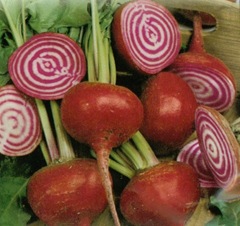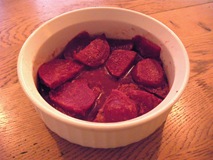 First, in the interest of hybridization, I am cross-pollinating my blogs by introducing a post that I put up quite awhile ago on my amalgamatedclyde blog. I've since migrated most of that blog to syntheticblog. Don't fret, I only like synthetic food that has been made by hand with natural ingredients.
First, in the interest of hybridization, I am cross-pollinating my blogs by introducing a post that I put up quite awhile ago on my amalgamatedclyde blog. I've since migrated most of that blog to syntheticblog. Don't fret, I only like synthetic food that has been made by hand with natural ingredients.
Second, it has come to my attention that, in this year of potato abundance, as a rather odd inverse of the Irish Famine that began in 1845, our CSA members are having a bit of a struggle to figure out what to do with all of their crop. Furthering the 'oddness' of this situation, the 'Late Blight' struck the tomato crop this year without mercy, as we all know by now.
So, placing second first, I should like to put you on to a recipe that is mostly one of simple technique, to which I gave little increments of thought, and in the end, though I knew it had taken years of experimentation to perfect the outcome, I had only a dim awareness that this small series of juxtapositions of experimental outcomes would matter to someone else, until I fed the roasted potatoes to my neighbor and she asked how I did it. Humbly flattered- she herself is an accomplished cook, I shared my recipe in detail and would like to do so now with all of you.
When people mock the exactitude with which I chop like-vegetables into the same size, they tend mistakenly to attribute this to obsessive-compulsive disorder, when, in fact the physics of heat flow, based on similar surface areas and vegetable volume are the real reason. That's just how you control how much it cooks. Keeping this as rule number one (cut every piece the same: bite-size) we may begin.
Ingredients:
- Potatoes to feed the lot of you.
- 2-4 cloves of garlic. 5 if you prefer.
- enough olive oil to coat your skillet and a bit more
- a secret pat of butter
- minced rosemary
- salt and pepper
- parsley? You decide.
Preparation:
With any of the varieties we have received, a thorough washing is the best place to begin, but skip any peeling.
Pre-heat your oven to 350 degrees.
Plan your dicing in a 3-dimensional coordinate space and you will get lots of cubes. Do I have to draw this?
Heat your skillet. It had better be big enough to hold all the potatoes. When it's getting too hot to touch with your hand, stop touching it and add the olive oil. Whirl it until it visibly thins in viscosity. Add the secret pat of butter while no one is looking and let it melt into the oil.
Crush the garlic with the flat part of a knife, or use a hammer if you prefer. You want to expose the inner flesh but keep the cloves intact so you can remove them later. Who wants to eat burned garlic?
Saute the garlic for a few minutes, extracting as much garlic juice as is practical. When it starts to brown, remove it to the the waste bin or composter.
Add the potatoes and jack-up the heat. Turn constantly with a spatula. As they begin to brown, add salt and pepper. Stir more.
Now, add the minced rosemary. Remove from the stove and pop into the oven. You can cook it covered or uncovered. Both ways seem ok to me.
After 15-20 minutes, stick a fork in 'em and see if they are done.
Choose now to toss in minced parsley, or forever hold your peace.
Consume.
---------Ok onto issue number one:
Several years ago, when Daniel Boulud opened another of his grand palaces of degustation, I noted that the menu included, nay, featured, certain items that should only be characterized as offal, and also, though perhaps not fitting precisely within this characterization, pieds de cochons, which I am pretty sure is French for 'proceed with caution.' I took it all as the antics of another bored chef-genius, who, tiring of short ribs and steak-frites, felt the need to delve deeper within his animal. A press release quoted him saying he had been 'transported back to the food of his childhood.' A recent glance at the Bar Boulud menu turned up this telltale positioning of charcuterie as merely 'cute':
FROMAGE DE TÊTE GILLES VEROT
HEAD CHEESE TERRINE
GILLES VEROT'S AWARD WINNING SPECIALTY
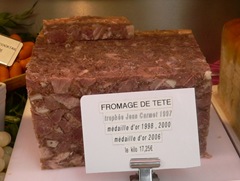
My main purpose here, though, is not to dwell on innards and the pursuit of grossification, but to point out that in cooking, the dream of the Alchemist sees its true realization. From baser ingredients come precious masterpieces. There is a certain process whereby the humble onion, the potato, a pasta, bean, a simple thing, achieves a unity with its fellow pot-sharing comestibles that is not fully explicable in terms of the backward-engineered recipe, as achievable as this may be. E pluribus unum, as the dollar bill would have it: out of many, one. Call it a gestalt of cooking. The 'season, taste, repeat' cycle of fine-tuning flavors is aimed at hitting a bulls-eye that is a unitary experience, not a mere mixture of ingredients. I submit for your approval: the mac 'n cheese, the chili, the pasta e fagioli. A catalog of comfort foods, perhaps, but ones built upon a few simple ingredients that magically harmonize in one another's presence like the understudy cast of a Broadway play who, together, trump a playbill of stars.
|
| And so I turn to another such recipe, one that I've only recently encountered, but which perfectly fits into this category: Bacalhau à Brás. This is a Portuguese recipe which I can describe, without oversimplifying, as a salt-cod hash. I first sampled it in Maplewood NJ at Churrasco BBQ & Steakhouse. The video clip shown above is a bit more high-brow in execution, with its fancy prawns and cucumber, but is still in the same vein. 
|


Let me rewind a bit to touch on my fascination with salt-cod. It's a big topic and an entire foodie book has been written about it. I really haven't read that book, so I'll just summarize according to another book I haven't read. If you remember anything about 'Mutiny on the Bounty,' you'll recall Captain Bligh, whose name sometimes connotes cruelty, but should instead summon the qualities of intellect, loyalty and steadfast courage. He was a brilliant sailor, managing to navigate 3000 miles of the Pacific, in a dingy, to save the lives of the fraction of the crew who fulfilled their sworn allegiance to the captain of their vessel. Well, it turns out that Bligh's mission, foiled in the famous case, but later revisited, was to transplant breadfruit trees from the Pacific Islands to the Islands of the Caribbean in order to feed a growing population of slaves, cut-off by the Revolutionary war from their life-sustaining supply of salt-cod. As it so happened, the enslaved workers balked at the breadfruit, in all of its various preparations: steamed, as a pudding, tofurkey style- none of it was for them. Even today, throughout the Caribbean, you will find the lingering evidence in a continued reverence for salt-cod dishes. And let's not forget who was doing all that fishing. It was the Portuguese emigrant, who had settled in Newfoundland or Fall River, or New Bedford. They sailed out on large creaky vessels and then were dropped over the side in tippy little dories with nothing more than oars, hooks, bait, and a few hundred feet of fishing line. But they caught lots of fish! Of course, in the absence of refrigeration, the proven method of preserving their catch was desiccation through salting. In a culinary sense, this is where my interest was piqued.
One revives the salted fish through immersion in a fresh-water bath, changing the water over the course of a couple of days, by which time most of the salt will have been removed. Today this happens in the fridge of course, but I suppose it would have been done at room temperature in bygone days. Bye, gone days! Now the fish is ready for cooking. Whichever recipe you choose, one fact that becomes apparent immediately is that you have not, through the water bath process, returned the filets to their pristine state, for the salt exerts a curing action on the flesh which causes a subtle, curious and, in my opinion, delectable adulteration in its flavor. Its the difference between picnic shoulder and ham.
 At the outset of this peripatetic discourse I promised a recipe, so let me hop to it, lest this post languish interminably in 'draft' mode. If you happen to own this cool Euro cookbook, 1080 Recipes, you need only turn to recipe 551, where the dish is named in the descriptive fashion 'Bacalao con Patatas Paja y Huevos Revueltos'. So now you know the secret: it's basically shredded bacalao with fried matchstick potatoes, onions, and scrambled eggs. It couldn't be simpler, ingredient-wise. Keeping a blind eye to the cardiovascular and caloric demands of the dish, let me elaborate a little bit on the magic that happens when you follow the recipe. First, you crisp the thinly-julienned potatoes in sunflower oil and set them aside. Then, reserving a small amount of the oil of the sunflower, you add the onions, which have been sliced, and pulled into rings, and then, ever so slowly, you coax them into a sweet, light-brown, gloriously softened manifestation of their original harsh selves. Following, you add the desalted cod, which I meticulously shredded into threads of exactly the same size, but which you may pull apart in a less obsessive-compulsive fashion. Did I mention that cooking can be therapeutic?
At the outset of this peripatetic discourse I promised a recipe, so let me hop to it, lest this post languish interminably in 'draft' mode. If you happen to own this cool Euro cookbook, 1080 Recipes, you need only turn to recipe 551, where the dish is named in the descriptive fashion 'Bacalao con Patatas Paja y Huevos Revueltos'. So now you know the secret: it's basically shredded bacalao with fried matchstick potatoes, onions, and scrambled eggs. It couldn't be simpler, ingredient-wise. Keeping a blind eye to the cardiovascular and caloric demands of the dish, let me elaborate a little bit on the magic that happens when you follow the recipe. First, you crisp the thinly-julienned potatoes in sunflower oil and set them aside. Then, reserving a small amount of the oil of the sunflower, you add the onions, which have been sliced, and pulled into rings, and then, ever so slowly, you coax them into a sweet, light-brown, gloriously softened manifestation of their original harsh selves. Following, you add the desalted cod, which I meticulously shredded into threads of exactly the same size, but which you may pull apart in a less obsessive-compulsive fashion. Did I mention that cooking can be therapeutic?
After a little browning, the last step is to crack the eggs directly into the hot skillet, scramble them with a fork and, as they begin to solidify, add the crunchy potatoes. After the whole thing firms up, it's ready for plating. I added some Chohula Hot Sauce, but Crystal, Frank's, or Goya would all be appropriate, or skip the hot sauce altogether if you can't handle it. Don't be ashamed, just enjoy.


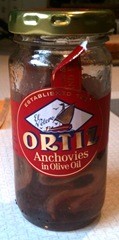
 Splurge on some of these anchovies. They are worth the price, if only from time-to-time. Maybe they aren't your everyday anchovy, but they come with this cool mini-fork that allows you to spear-fish right from the jar.
Splurge on some of these anchovies. They are worth the price, if only from time-to-time. Maybe they aren't your everyday anchovy, but they come with this cool mini-fork that allows you to spear-fish right from the jar.












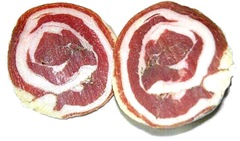




 So what exactly is that gorgeous looking bouquet of flowers and leafy tendrils in your share this week? Pea shoots, who would ever think to eat these was really on to something. They taste just like peas and are perfect for a delicate summer salad. In Chinese cuisine they have been popular for years, they are loaded with Vitamins A and C.
So what exactly is that gorgeous looking bouquet of flowers and leafy tendrils in your share this week? Pea shoots, who would ever think to eat these was really on to something. They taste just like peas and are perfect for a delicate summer salad. In Chinese cuisine they have been popular for years, they are loaded with Vitamins A and C.